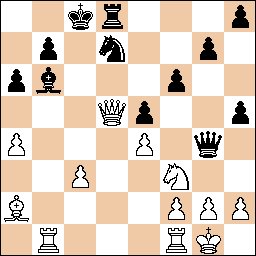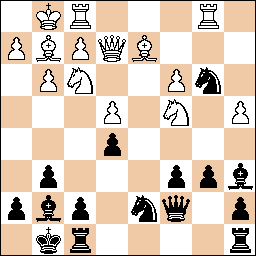Tuesday, March 28, 2006
Space Factor
Is space a real factor? I say yes. Although what I posted here certainly brings up the double-edged quality of pushing a pawn, it's generally more of a plus than the minus. Summarizing I think the big plus an overall space advantage typically gives one is less options for your opponent's pieces in his own territory and more options for you to perform exchanges, simple tactics, sacrifices for promotion, or other combinations in his territory. That seems real. And I know that tactics can happen anywhere, but I think it's much more annoying to threaten things deep in the other half of the board.
In an even, symmetrical position (especially with the center pawns locked), I often think to go for space. You could argue that that a move isn't so much about space, but rather a plan to control certain advanced squares while simultaneously blocking your opponent from pushing his pawn forward. That's simply a matter of semantics, and I think it's simpler to call it "space".
I read a bit in my old copy of My System, looking for space discussion. Nimzovich doesn't focus on space much but rather the center and development, emphatically so.
Tying this in, think how chess engines work. Every pawn push that doesn't compromise King safety adds a little bonus to the position, and the center pawns get bigger bonuses as they advance. As pawns near promotion, the positional bonus increases. Engines do pretty well with this approach, which pretty much seems like treating space as a real factor.
TCT Results | Circle 1 | Circle 2 | Circle 3 | Circle 4 | Circle 5 | Circle 6 | Circle 7 |
| Step 1 | 97% | 99% | 99% | 100%r | |||
| Step 2 | 93% | 96% | 95% | 97% | 96% | 99% | 100% |
| Step 3 | 93% | 97% | 97% | 96% | 96% | 98% | 99% |
| Step 4 | 80% | 86% | 90% | 92% | 88%* | ||
| Step 5 | 74% | 77% | 83% | 87% |
Wednesday, March 22, 2006
Review Rust
*Sigh*
This has been a bit disappointing, but I just take it as feedback that if I really want to know those problems better, more circles or review is required. I am pretty much tired of spending most of my chess time solving problems, too. After seeing how much review I am going to need to be more consistent, I have decided to drop down to 4-5 days a week for TCT. I am aiming at getting in some opening review once a week, continue with looking at parts of annotated games at least once a week, and every now and then toss in checkmates, Knight drills, Micro drills, review, and of course some form of play. This actually isn't different from when I started the circles, but that shifted into months chiefly solving problems from TCT. It's time to start putting it all together.
Also, I am going to bring TCT problems into Fritz more regularly to see what I missed in the position.
-=-=-=-=-
Tasc Chess Tutor: Step 4, 3D, #2

White - Black, Tasc Chess Tutor 2006
2kr3p/1p1n2p1/pb3p2/3Qp2p/P3P1q1/2P2N2/B4PPP/1R3RK1 w - - 0 1
Analysis by Fritz 8:
1. +- (9.70): 1.h3 Qg6 2.Nh4 Qe8 3.Nf5 Nc5 4.Qd6 Rxd6 5.Nxd6+ Kd7 6.Nxe8 Kxe8
2. +- (9.20): 1.Qf7 Bc5 2.Bd5 Rf8 3.Bxb7+ Kd8 4.Qc4 Ke7 5.Rfd1 Rd8
3. +- (8.55): 1.Qc4+ Kb8 2.Qb4 Rc8 3.a5
4. +- (7.96): 1.Rxb6 Nxb6 2.Qc5+ Kb8 3.Qxb6 Qd7 4.Bd5 Qc7 5.Rb1 Qxb6 6.Rxb6 Rd7 7.a5
5. +- (7.75): 1.Rfd1 Nc5 2.Qc4 Qxe4 3.Rxd8+ Kxd8 4.Rxb6 Qxc4 5.Bxc4 Nxa4 6.Rxb7 Kc8
6. +- (6.96): 1.a5 Nc5 2.Qc4 Ba7 3.Rfd1 Rd7 4.Qg8+ Kc7 5.Rxd7+ Qxd7 6.Bd5
7. +- (6.81): 1.Qe6 Qxe6 2.Bxe6 Ba5 3.Rfd1 Kc7 4.Bxd7 Rxd7 5.Rxd7+ Kxd7 6.Rxb7+ Kc8 7.Rb3 Kc7
8. +- (6.68): 1.Rbd1
Knowing TCT, I expected sacrificing the exchange to set up a fork to be the answer with Rxb6 which is their answer. I felt certain that a5 was strong, perhaps stronger than Rxb6, but was wrong. I couldn't see how to do better than those moves, although I thought there might be some Queen move that set up threats of Be6. Consulting Fritz it turns out everything is winning. Fritz's 1. Qf7 was a huge surprise, something I probably wouldn't ever consider, though in retrospect it makes Be6 a reality in a very simple way. Fritz's 1. h3 was a little bit of a surprise, too.
One bad habit that I have gotten into is focusing so much on solving the problem that I forget about defense. In the above position I forgot that by moving White's Queen (1.Rxb6 Nxb6 2.Qc5+ Kb8 3.Qxb6 ) the e4 pawn can be captured by Black Queen.
In a blitz game this position came up. I thought there were some possibilities down the h file, but I couldn't figure it out and went with what was popping up in my mind as an obvious combination: ...Qxg2+ Kxg2 Rg6+ Kh1 Bxd7, netting a pawn. This move goes under the heading "kind of funny, kind of painful". The incredibly simple ...Rg6 threatens mate in 1 and discovers the attack on the Queen simultaneously.
TCT Results | Circle 1 | Circle 2 | Circle 3 | Circle 4 | Circle 5 | Circle 6 | Circle 7 |
| Step 1 | 97% | 99% | 99% | 100%r | |||
| Step 2 | 93% | 96% | 95% | 97% | 96% | 99% | 100% |
| Step 3 | 93% | 97% | 97% | 96% | 96% | 98% | 99% |
| Step 4 | 80% | 86% | 90% | 92% | 89%* | ||
| Step 5 | 74% | 77% | 83% | 87% |
Monday, March 13, 2006
Step 3 Complete!
I went through another annotated game in The Art of Logical Thinking. In Nunn vs Solokov on move 18 (p. 49), I wonder why McDonald didn't analyze White sacrificing the exchange.
seems worth considering, where the Black King will be forced onto either the d or f file, thus allowing the a-1 Rook to essentially develop with tempo. Black's Bishop and Rooks are not developed and White is more active. The resulting position is a bit beyond me, and I would have appreciated some master help.
This book continues to drive home how frequently GMs are doing 2 or even 3 things in a turn. This is exactly what I am not doing, which seems to be indicated in my blitz play and rating. I am not seeing alot of what is on the board, and on average I am having less ideas, especially as compared to last month. After thinking about it awhile, I have concluded that the boost in blitz performance last month was due to working on the "Simultaneous Advantage" document. I worked on it for three months, and, combined with the circles, I must have been in a better tactical state of mind. Soon after I finished it, I stopped thinking about it (as it was done), and now something has faded from my play. For me, learning tactics is the opposite of learning how to ride a bike; any tactical theme can be forgotten, sometimes rather quickly.
Anyway, as a remedy I am going to review my own darn post and post-mortem my games more from a simultaneous advantage point of view.
TCT Results | Circle 1 | Circle 2 | Circle 3 | Circle 4 | Circle 5 | Circle 6 | Circle 7 |
| Step 1 | 97% | 99% | 99% | 100%r | |||
| Step 2 | 93% | 96% | 95% | 97% | 96% | 99% | 100% |
| Step 3 | 93% | 97% | 97% | 96% | 96% | 98% | 99% |
| Step 4 | 80% | 86% | 90% | 92% | |||
| Step 5 | 74% | 77% | 83% | 87% |
Thursday, March 09, 2006
US Chess Championship

12.Nxf7! threatens the Black Queen, making the Black King take and netting a pawn.
[Event "United States Championship 2006"]
[Site "San Diego USA"]
[Date "2006.03.08"]
[Round "6"]
[White "Ibragimov, I."]
[Black "Fernandez, D."]
[Result "1-0"]
[WhiteElo "2635"]
[BlackElo "2423"]
[ECO "E15"]
1.c4 Nf6 2.d4 e6 3.Nf3 b6 4.g3 Ba6 5.Nbd2 c5 6.Bg2 Bb7 7.e4 cxd4 8.e5 Ng4 9.O-O d6
10.h3 Nxe5 11.Nxe5 Bxg2 12.Nxf7 Kxf7 13.Kxg2 Nd7 14.Ne4 Be7 15.Qxd4 Nc5 16.Re1 d5
17.Nxc5 Bxc5 18.Qf4+ Qf6 19.cxd5 exd5 20.Qc7+ Kg6 21.Bf4 Rhe8 22.Qd7 Rad8 23.Qg4+
Kf7 24.Rxe8 Rxe8 25.Rd1 Kg8 26.Qf3 Kh8 27.Rxd5 Rf8 28.b3 h6 29.h4 Qb2 30.Rd2 Qb1
31.Qd3 Qa1 32.Re2 Qf6 33.h5 Qf7 34.Re5 Qb7+ 35.Qd5 1-0
White to Move

Under time pressure 53. Kg5?! was played, and White missed his big winning chance. 53. Rd7! threatens mate and the Knight, with ...fxg6 being met with fxg6.
[Event "United States Championship 2006"]
[Site "San Diego USA"]
[Date "2006.03.05"]
[Round "3"]
[White "Benjamin, J."]
[Black "Friedel, J."]
[Result "1/2-1/2"]
[ECO "C91"]
[WhiteElo "2576"]
[BlackElo "2455"]
[PlyCount "121"]
[EventDate "2006.??.??"]
[WhiteTeam "United States"]
[BlackTeam "United States"]
[WhiteTeamCountry "USA"]
[BlackTeamCountry "USA"]
1. e4 e5 2. Nf3 Nc6 3. Bb5 a6 4. Ba4 Nf6 5. O-O Be7 6. Re1 b5 7. Bb3 d6 8. c3
O-O 9. d4 Bg4 10. d5 Na5 11. Bc2 c6 12. h3 Bc8 13. dxc6 Qc7 14. Nbd2 Qxc6 15.
Nf1 Re8 16. a4 Be6 17. Ng5 Bd7 18. Ne3 h6 19. Nf3 Be6 20. Nd2 g6 21. Qf3 Nb7
22. a5 Qc7 23. Nf5 gxf5 24. exf5 Bd5 25. Ne4 Bxe4 26. Bxe4 d5 27. Bxd5 Nxd5 28.
Qxd5 Bg5 29. Bxg5 hxg5 30. h4 Rad8 31. Qf3 Nd6 32. hxg5 e4 33. Qf4 Qc5 34. g4
Qe5 35. Qxe5 Rxe5 36. Rad1 Ree8 37. b4 Kf8 38. Rd5 Nc4 39. Rxd8 Rxd8 40. Rxe4
Rd3 41. f6 Rxc3 42. Re7 Nd6 43. Ra7 Rc6 44. Kg2 Ke8 45. f4 Nc8 46. Rb7 Rc4 47.
Kg3 Rxb4 48. f5 Nd6 49. Re7+ Kf8 50. g6 Kg8 51. Kh3 Rb3+ 52. Kh4 Rb1 53. Kg5
53... Rf1 54. Kh5 Rh1+ 55. Kg5 Rf1 56. gxf7+ Nxf7+ 57. Kh4 Rh1+ 58. Kg3 Ra1
59. Re8+ Kh7 60. Re7 Kg8 61. Re8+ 1/2-1/2
TCT Results | Circle 1 | Circle 2 | Circle 3 | Circle 4 | Circle 5 | Circle 6 | Circle 7 |
| Step 1 | 97% | 99% | 99% | 100%r | |||
| Step 2 | 93% | 96% | 95% | 97% | 96% | 99% | 100% |
| Step 3 | 93% | 97% | 97% | 96% | 96%* | 98%* | 99%* |
| Step 4 | 80% | 86% | 90% | 92% | |||
| Step 5 | 74% | 77% | 83% | 87% |
Friday, March 03, 2006
Little to Report
Hellos go out to new and returning Knights.
Black to Move
Here is another interesting mistake from a blitz game. In a rush I played ...Bxc4?, but afterwards I saw that putting the Black Knight on the edge with ...Na5! gangs up on the pinned White Knight. The b1-Rook cannot help as ...Na5 Rb4 c5 causes problems for White.
-=-=-=-=-
TCT Results | Circle 1 | Circle 2 | Circle 3 | Circle 4 | Circle 5 | Circle 6 | Circle 7 |
| Step 1 | 97% | 99% | 99% | 100%r | |||
| Step 2 | 93% | 96% | 95% | 97% | 96% | 99% | 100% |
| Step 3 | 93% | 97% | 97% | 96% | 96%* | 98%* | 100%* |
| Step 4 | 80% | 86% | 90% | 92% | |||
| Step 5 | 74% | 77% | 83% | 87% |



